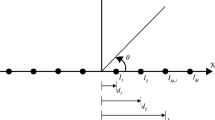Abstract
To consider multi-objective optimization problem with the number of feed array elements and sidelobe level of large antenna array, multi-objective cross entropy (CE) algorithm is proposed by combining fuzzy c-mean clustering algorithm with traditional cross entropy algorithm, and specific program flow of the algorithm is given. Using the algorithm, large thinned array (200 elements) given sidelobe level (−10, −19 and −30 dB) problem is solved successfully. Compared with the traditional statistical algorithms, the optimization results of the algorithm validate that the number of feed array elements reduces by 51%, 11% and 6% respectively. In addition, compared with the particle swarm optimization (PSO) algorithm, the number of feed array elements from the algorithm is more similar, but the algorithm is more efficient.
Similar content being viewed by others
References
Cohen I, Golany B, Shtub A. Managing stochastic, finite capacity, multi-project systems through the cross-entropy methodology [J]. Annals of Operations Research, 2005, 134(1): 183–199.
Deb K. Multi-objective optimization using evolutionary algorithms [M]. Chichester, UK: Wiley, 2001: 84–90.
Deb K, Agrawal S, Pratap A, et al. A fast and elitist multi-objective genetic algorithm: NSGA-II [J]. IEEE Transactions on Evolutionary Computation, 2002, 2(6): 182–196.
Corne D W, Jerram N R, Knowles J D, et al. PESA-II: Region-based selection in evolutionary multiobjective optimization [C]//Proceedings of the Genetic and Evolutionary Computation Conference. San Francisco, California: Morgan Kaufmann Publishers, 2001: 283–290.
Zitzler E, Laumanns M, Thiele L. SPEA2: Improving the strength Pareto evolutionary algorithm [R]. Zurich, Switzerland: Swiss Federal Institute of Technology, 2001.
Skolnik M, Sherman J, Ogg F. Statistically designed density-tapered arrays [J]. IEEE Transactions on Antennas and Propagation, 1964, 12(4): 408–417.
Lo Y. A mathematical theory of antenna arrays with randomly spaced elements [J]. IEEE Transactions on Antennas and Propagation, 1964, 12(3): 257–268.
Steinberg B D. Microwave imaging with large antenna arrays [M]. New York: Wiley, 1983: 37–39.
Yan K K, Lu Y. Sidelobe reduction in array-pattern synthesis using genetic algorithm [J]. IEEE Transactions on Antennas and Propagation, 1997, 45(7): 1117–1122.
Wang L L, Fang D G. Genetic algorithm for the synthesis of thinned array [J]. Acta Electronica Sinica, 2003, 31(12): 2135–2138 (in Chinese).
Trucco A. Thinning and weighting of large planar arrays by simulated annealing [J]. IEEE Transactions on Ultrasonics, Ferroelectrics and Frequency Control, 1999, 46(2): 347–355.
Jin N, Rahmat-Samii Y. Advances in particle swarm optimization for antenna designs: Real-number, binary, single-objective and multi-objective implementations [J]. IEEE Transactions on Antennas and Propagation, 2007, 55(3): 556–567.
Pulido G T, Coello C A C. Using clustering techniques to improve the performance of a particle swarm optimizer [C]//Proceedings of the 2004 Genetic and Evolutionary Computation Conference. Seattle, USA: Springer, 2004: 225–237.
Mostaghim S, Teich J. The role of e-dominance in multi-objective particle swarm optimization method [C]//Proceedings of the 2003 Congress on Evolutionary Computation. Canberra, Australia: IEEE 2003: 1764–1771.
Balling R. The maximin fitness function: Multiobjective city and regional planning [C]//Proceedings of the 2nd International Conference on Evolutionary Multi-criterion Optimization. Faro, Portugal: Springer, 2003: 1–15.
Quevedo-Teruel O, Rajo-Iglesias E. Ant colony optimization in thinned array synthesis with minimum sidelobe level [J]. IEEE Antennas and Wireless Propagation Letter, 2006, 5(1): 349–352.
Razavi A, Forooraghi K. Thinned arrays using pattern search algorithms [J]. Progress in Electromagnetics Research, 2008, 78: 61–71.
Rubinstein R Y. Optimization of computer simulation models with rare events [J]. European Journal of Operational Research, 1997, 99(1): 89–112.
Mailloux R J. Phased array antenna handbook [M]. 2nd ed. Norwood, MA: Artech House, 2005: 92–106.
Bezdek J C. Pattern recognition with fuzzy objective function algorithms [M]. New York: Springer, 1981: 56–57.
Author information
Authors and Affiliations
Corresponding author
Additional information
Foundation item: the National Natural Science Foundation of China (No. 51474100), the Youth Science Fund of Heilongjiang Province in China (No. QC2010023), and the Youth Outstanding Ability Program in Heilongjiang University of Science and Technology
Rights and permissions
About this article
Cite this article
Bian, L., Bian, Cy. & Wang, Sm. Large thinned array design based on multi-objective cross entropy algorithm. J. Shanghai Jiaotong Univ. (Sci.) 20, 437–442 (2015). https://doi.org/10.1007/s12204-015-1645-4
Received:
Published:
Issue Date:
DOI: https://doi.org/10.1007/s12204-015-1645-4
Keywords
- thinned array
- multi-objective optimization
- cross entropy (CE) algorithm
- particle swarm optimization (PSO) algorithm




